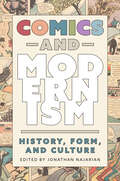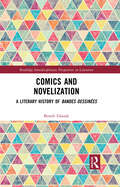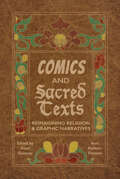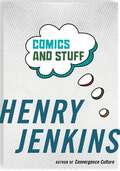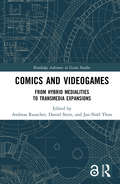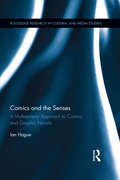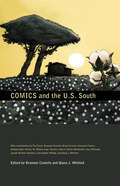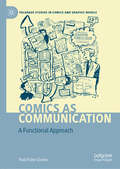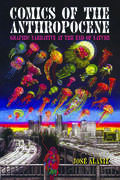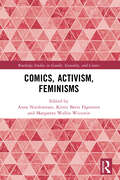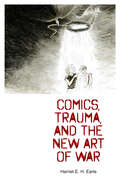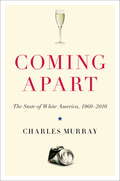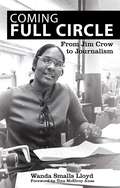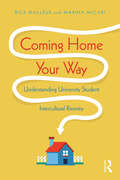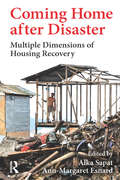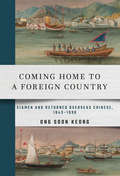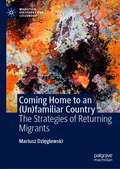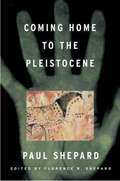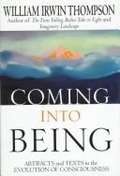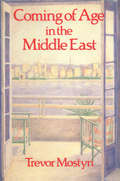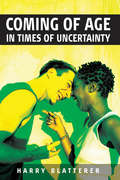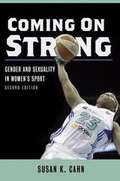- Table View
- List View
Comics and Modernism: History, Form, and Culture (Tom Inge Series on Comics Artists)
by Jonathan NajarianContributions by David M. Ball, Scott Bukatman, Hillary Chute, Jean Lee Cole, Louise Kane, Matthew Levay, Andrei Molotiu, Jonathan Najarian, Katherine Roeder, Noa Saunders, Clémence Sfadj, Nick Sturm, Glenn Willmott, and Daniel Worden Since the early 1990s, cartoonist Art Spiegelman has made the case that comics are the natural inheritor of the aesthetic tradition associated with the modernist movement of the early twentieth century. In recent years, scholars have begun to place greater import on the shared historical circumstances of early comics and literary and artistic modernism. Comics and Modernism: History, Form, and Culture is an interdisciplinary consideration of myriad social, cultural, and aesthetic connections. Filling a gap in current scholarship, an impressively diverse group of scholars approaches the topic from a variety of disciplinary backgrounds and methodologies. Drawing on work in literary studies, art history, film studies, philosophy, and material culture studies, contributors attend to the dynamic relationship between avant-garde art, literature, and comics. Essays by both established and emerging voices examine topics as divergent as early twentieth-century film, museum exhibitions, newspaper journalism, magazine illustration, and transnational literary circulation. In presenting varied critical approaches, this book highlights important interpretive questions for the field. Contributors sometimes arrive at thoughtful consensus and at other times settle on productive disagreements. Ultimately, this collection aims to extend traditional lines of inquiry in both comics studies and modernist studies and to reveal overlaps between ostensibly disparate artistic practices and movements.
Comics and Novelization: A Literary History of Bandes Dessinées (Routledge Interdisciplinary Perspectives on Literature)
by Benoît GlaudeThis book opens a novel perspective on comics and literature interactions. It claims that the two artistic media have always maintained a mutual emulation, for as long as they have coexisted in media culture. To demonstrate this, the present research does not focus on literary adaptations in comics form but rather on a literary corpus that remains virtually unexplored: comics-related novels. The purpose of this volume is to inventory French comics-related novels and to study them. Within the limits of the French-speaking world, this book pieces together a literary history of bande dessinée through its novels, from the nineteenth to twenty-first centuries. Although the comic strip – including the aptly named "graphic novel" – has sometimes been regarded as the disciple of an unsurpassable literary model, do these under-studied adaptations in novel form not rather indicate a mutual relationship, or even an emulation, between the two media?
Comics and Sacred Texts: Reimagining Religion and Graphic Narratives
by Assaf Gamzou and Ken Koltun-FrommContributions by Ofra Amihay, Madeline Backus, Samantha Baskind, Elizabeth Rae Coody, Scott S. Elliott, Assaf Gamzou, Susan Handelman, Leah Hochman, Leonard V. Kaplan, Ken Koltun-Fromm, Shiamin Kwa, Samantha Langsdale, A. David Lewis, Karline McLain, Ranen Omer-Sherman, Joshua Plencner, and Jeffrey L. RicheyComics and Sacred Texts explores how comics and notions of the sacred interweave new modes of seeing and understanding the sacral. Comics and graphic narratives help readers see religion in the everyday and in depictions of God, in transfigured, heroic selves as much as in the lives of saints and the meters of holy languages. Coeditors Assaf Gamzou and Ken Koltun-Fromm reveal the graphic character of sacred narratives, imagining new vistas for both comics and religious texts. In both visual and linguistic forms, graphic narratives reveal representational strategies to encounter the sacred in all its ambivalence. Through close readings and critical inquiry, these essays contemplate the intersections between religion and comics in ways that critically expand our ability to think about religious landscapes, rhetorical practices, pictorial representation, and the everyday experiences of the uncanny. Organized into four sections—Seeing the Sacred in Comics; Reimagining Sacred Texts through Comics; Transfigured Comic Selves, Monsters, and the Body; and The Everyday Sacred in Comics—the essays explore comics and graphic novels ranging from Craig Thompson’s Habibi and Marvel’s X-Men and Captain America to graphic adaptions of religious texts such as 1 Samuel and the Gospel of Mark.Comics and Sacred Texts shows how claims to the sacred are nourished and concealed in comic narratives. Covering many religions, not only Christianity and Judaism, this rare volume contests the profane/sacred divide and establishes the import of comics and graphic narratives in disclosing the presence of the sacred in everyday human experience.
Comics and Stuff
by Henry JenkinsConsiders how comics display our everyday stuff—junk drawers, bookshelves, attics—as a way into understanding how we represent ourselves nowFor most of their history, comics were widely understood as disposable—you read them and discarded them, and the pulp paper they were printed on decomposed over time. Today, comic books have been rebranded as graphic novels—clothbound high-gloss volumes that can be purchased in bookstores, checked out of libraries, and displayed proudly on bookshelves. They are reviewed by serious critics and studied in university classrooms. A medium once considered trash has been transformed into a respectable, if not elite, genre.While the American comics of the past were about hyperbolic battles between good and evil, most of today’s graphic novels focus on everyday personal experiences. Contemporary culture is awash with stuff. They give vivid expression to a culture preoccupied with the processes of circulation and appraisal, accumulation and possession. By design, comics encourage the reader to scan the landscape, to pay attention to the physical objects that fill our lives and constitute our familiar surroundings. Because comics take place in a completely fabricated world, everything is there intentionally. Comics are stuff; comics tell stories about stuff; and they display stuff.When we use the phrase “and stuff” in everyday speech, we often mean something vague, something like “etcetera.” In this book, stuff refers not only to physical objects, but also to the emotions, sentimental attachments, and nostalgic longings that we express—or hold at bay—through our relationships with stuff.In Comics and Stuff, his first solo authored book in over a decade, pioneering media scholar Henry Jenkins moves through anthropology, material culture, literary criticism, and art history to resituate comics in the cultural landscape. Through over one hundred full-color illustrations, using close readings of contemporary graphic novels, Jenkins explores how comics depict stuff and exposes the central role that stuff plays in how we curate our identities, sustain memory, and make meaning. Comics and Stuff presents an innovative new way of thinking about comics and graphic novels that will change how we think about our stuff and ourselves.
Comics and Videogames: From Hybrid Medialities to Transmedia Expansions (Routledge Advances in Game Studies)
by Andreas RauscherThis book offers the first comprehensive study of the many interfaces shaping the relationship between comics and videogames. It combines in-depth conceptual reflection with a rich selection of paradigmatic case studies from contemporary media culture. The editors have gathered a distinguished group of international scholars working at the interstices of comics studies and game studies to explore two interrelated areas of inquiry: The first part of the book focuses on hybrid medialities and experimental aesthetics "between" comics and videogames; the second part zooms in on how comics and videogames function as transmedia expansions within an increasingly convergent and participatory media culture. The individual chapters address synergies and intersections between comics and videogames via a diverse set of case studies ranging from independent and experimental projects via popular franchises from the corporate worlds of DC and Marvel to the more playful forms of media mix prominent in Japan. Offering an innovative intervention into a number of salient issues in current media culture, Comics and Videogames will be of interest to scholars and students of comics studies, game studies, popular culture studies, transmedia studies, and visual culture studies.
Comics and the Senses: A Multisensory Approach to Comics and Graphic Novels (Routledge Research in Cultural and Media Studies)
by Ian HagueAttempts to define what comics are and explain how they work have not always been successful because they are premised upon the idea that comic strips, comic books and graphic novels are inherently and almost exclusively visual. This book challenges that premise, and asserts that comics is not just a visual medium. The book outlines the multisensory aspects of comics: the visual, audible, tactile, olfactory and gustatory elements of the medium. It rejects a synaesthetic approach (by which all the senses are engaged through visual stimuli) and instead argues for a truly multisensory model by which the direct stimulation of the reader’s physical senses can be understood. A wide range of examples demonstrates how multisensory communication systems work in both commercial and more experimental contexts. The book concludes with a case study that looks at the works of Alan Moore and indicates areas of interest that multisensory analysis can draw out, but which are overlooked by more conventional approaches.
Comics and the U.S. South
by Brannon CostelloComics and the U.S. South offers a wide-ranging and long overdue assessment of how life and culture in the United States South is represented in serial comics, graphic novels, newspaper comic strips, and webcomics. Diverting the lens of comics studies from the skyscrapers of Superman's Metropolis or Chris Ware's Chicago to the swamps, backroads, small towns, and cities of the U.S. South, this collection critically examines the pulp genres associated with mainstream comic books alongside independent and alternative comics.Some essays seek to discover what Captain America can reveal about southern regionalism and how slave narratives can help us reread Swamp Thing; others examine how creators such as Walt Kelly (Pogo), Howard Cruse (Stuck Rubber Baby), Kyle Baker (Nat Turner), and Josh Neufeld (A.D.: New Orleans after the Deluge) draw upon the unique formal properties of the comics to question and revise familiar narratives of race, class, and sexuality; and another considers how southern writer Randall Kenan adapted elements of comics form to prose fiction. With essays from an interdisciplinary group of scholars, Comics and the U.S. South contributes to and also productively reorients the most significant and compelling conversations in both comics scholarship and in southern studies.
Comics as Communication: A Functional Approach (Palgrave Studies in Comics and Graphic Novels)
by Paul Fisher DaviesThis book explores how comics function to make meanings in the manner of a language. It outlines a framework for describing the resources and practices of comics creation and readership, using an approach that is compatible with similar descriptions of linguistic and multimodal communication. The approach is based largely on the work of Michael Halliday, drawing also on the pragmatics of Paul Grice, the Text World Theory of Paul Werth and Joanna Gavins, and ideas from art theory, psychology and narratology. This brings a broad Hallidayan framework of multimodal analysis to comics scholarship, and plays a part in extending that tradition of multimodal linguistics to graphic narrative.
Comics as a Research Practice: Drawing Narrative Geographies Beyond the Frame (Routledge Research in Culture, Space and Identity)
by Giada PeterleThis book proposes a novel creative research practice in geography based on comics. It presents a transdisciplinary approach that uses a set of qualitative visual methods and extends from within the geohumanities across literary spatial studies, comics, urban studies, mobility studies, and beyond. Written by a geographer-cartoonist, the book focuses on ‘narrative geographies’ and embraces a geocritical and relational approach to examine comic book geographies in pursuit of a growing interest in creative, art-based experimental methods in the geohumanities. It explores comics-based research through interconnections between art and geography and through theoretical and methodological contributions from scholars working in the fields of the social sciences, humanities, literary geographies, mobilities, comics, literary studies, and urban studies, as well as from visual artists, comics authors, and art practitioners. Comics are valuable objects of geographical interest because of their spatial grammar. They are also a language particularly suited to geographical analysis, and the ‘geoGraphic novel’ offers a practice of research that has the power to assemble and disassemble new spatial meanings. The book thus explores how the ‘geoGraphic novel’ as a verbo-visual genre allows the study of geographical issues, composes geocentred stories, engages wider and non-specialist audiences, promotes geo-artistic collaboration, and works as a narrative intervention in urban contexts. Through a practice-based approach and the internal perspective of a geographer-cartoonist, the book provides examples of how geoGraphic fieldwork is conducted and offers analysis of the processes of ideation, composition, and dissemination of geoGraphic narratives.
Comics of the Anthropocene: Graphic Narrative at the End of Nature
by José AlanizSince the first Earth Day in 1970, how have US comics artists depicted the human-caused destruction of the natural world? How do these representations manifest in different genres of comics like superheroes, biography, underground comix, and journalism? What resources unique to the comics medium do they bring to their tasks? How do these works resonate with the ethical and environmental issues raised by global conversations about the anthropogenic sixth mass extinction and climate change? How have comics mourned the loss of nature over the last five decades? Are comics “ecological objects,” in philosopher Timothy Morton’s parlance? Weaving together insights from comics studies, environmental humanities, critical animal studies, and affect studies to answer these questions, Comics of the Anthropocene: Graphic Narrative at the End of Nature explores the representation of animals, pollution, mass extinctions, and climate change in the Anthropocene Era, our current geological age of human-induced environmental transformation around the globe. Artists and works examined in Comics of the Anthropocene include R. Crumb, Don McGregor et al.’s Black Panther, Jack Kirby’s Kamandi: The Last Boy on Earth, the comics of the Pacific Northwest, and Stephen Murphy and Michael Zulli’s landmark alternative series The Puma Blues. This book breaks new ground in confronting our most daunting modern crisis through a discussion of how graphic narrative has uniquely addressed the ecology issue.
Comics, Activism, Feminisms (Routledge Studies in Gender, Sexuality, and Comics)
by Anna NordenstamComics, Activism, Feminisms explores from both historical and contemporary perspectives how comic art, activism, and feminisms are intertwined, and how comic art itself can be a form of activism.Feminist comic art emerged with the second-wave feminist movements. Today, there are comics connected to social activist movements working for change in a variety of areas. Comics artists often respond quickly to political events, making comics on topical issues that take a critical or satirical stance and highlighting the need for change. Comic art can point to problems, present alternatives, and give hope.Comics artists from all parts of the world engage issues pertaining to feminisms and LGBTQIA+ issues, war and political conflict, climate crisis, the global migrant and refugee situation, and other societal problems. The chapters of this anthology illuminate the aesthetic and thematic aspects of comics, activism, and feminisms globally. Particular attention is given to the work of comics collectives, where Do-it-Ourselves is a strategy among activism-oriented artists, which use a great variety of media, such as fanzines, albums, webcomics, and exhibitions to communicate and disseminate activist comic art.Comics, Activism, Feminisms is an essential anthology for scholars and students of comics studies, literary studies, art history, media studies, and gender studies.
Comics, Trauma, and the New Art of War
by Harriet E. EarleConflict and trauma remain among the most prevalent themes in film and literature. Comics has never avoided such narratives, and comics artists are writing them in ways that are both different from and complementary to literature and film. In Comics, Trauma, and the New Art of War, Harriet E. H. Earle brings together two distinct areas of research--trauma studies and comics studies--to provide a new interpretation of a long-standing theme. Focusing on representations of conflict in American comics after the Vietnam War, Earle claims that the comics form is uniquely able to show traumatic experience by representing events as viscerally as possible.Using texts from across the form and placing mainstream superhero comics alongside alternative and art comics, Earle suggests that comics are the ideal artistic representation of trauma. Because comics bridge the gap between the visual and the written, they represent such complicated narratives as loss and trauma in unique ways, particularly through the manipulation of time and experience. Comics can fold time and confront traumatic events, be they personal or shared, through a myriad of both literary and visual devices. As a result, comics can represent trauma in ways that are unavailable to other narrative and artistic forms.With themes such as dreams and mourning, Earle concentrates on trauma in American comics after the Vietnam War. Examples include Alissa Torres's American Widow, Doug Murray's The 'Nam, and Art Spiegelman's much-lauded Maus. These works pair with ideas from a wide range of thinkers, including Sigmund Freud, Mikhail Bakhtin, and Fredric Jameson, as well as contemporary trauma theory and clinical psychology. Through these examples and others, Comics, Trauma, and the New Art of War proves that comics open up new avenues to explore personal and public trauma in extraordinary, necessary ways.
Coming
by Jean-Luc NancyComing is a lyrical, erudite examination of the French notion of jouissance. How did jouissance evolve from referring to the pleasure of possessing a material thing (property, wealth) to the pleasure of orgasm, from appropriation to dis-appropriation, from consumption to consummation? The philosophers Adèle van Reeth and Jean-Luc Nancy engage in a lively dialogue, ranging from consumerism to video games to mysticism and from Spinoza, Hegel, andAugustine to the Marquis de Sade, Marguerite Duras, and Henry Miller. Four additional essays are new to the American edition.
Coming Apart: The State of White America, 1960-2010
by Charles MurrayFrom the bestselling author of Losing Ground and The Bell Curve, this startling long-lens view shows how America is coming apart at the seams that historically have joined our classes. In Coming Apart, Charles Murray explores the formation of American classes that are different in kind from anything we have ever known, focusing on whites as a way of driving home the fact that the trends he describes do not break along lines of race or ethnicity. Drawing on five decades of statistics and research, Coming Apart demonstrates that a new upper class and a new lower class have diverged so far in core behaviors and values that they barely recognize their underlying American kinship--divergence that has nothing to do with income inequality and that has grown during good economic times and bad. The top and bottom of white America increasingly live in different cultures, Murray argues, with the powerful upper class living in enclaves surrounded by their own kind, ignorant about life in mainstream America, and the lower class suffering from erosions of family and community life that strike at the heart of the pursuit of happiness. That divergence puts the success of the American project at risk. The evidence in Coming Apart is about white America. Its message is about all of America.
Coming Full Circle: From Jim Crow to Journalism
by Wanda Smalls LloydThis is the memoir of Wanda Lloyd Smalls, an African American woman who grew up privileged and educated in the restricted culture of the American South in the 1950s-1960s. Despite Jim Crow laws that affected where she lived, how she was educated, and what civil rights she would be denied, Lloyd grew up to realize her childhood dream of working as a professional journalist. In fact, she would eventually hold some of the nation's highest-ranking newspaper editorial positions and become one of the first African American women to be the top editor of a mainstream daily newspaper. Along the way she helped her newspapers and other media organizations understand how the lack of newsroom and staff diversity interfered with perceptions of accuracy and balance for their audiences. Her memoir is thus a window on the intersection of race, gender, culture, and the media's role in our uniquely American experiment in democracy. How Lloyd excelled in a profession where high-ranking African American women were rare is a memorable story that will educate, entertain, and inspire. Coming Full Circle is a self-reflective exploration of the author's life journey from growing up in coastal Savannah, Georgia, to editing roles at seven daily newspapers around the country, and circling back to her retirement in Savannah, where she led journalism education for a new generation.
Coming Full Circle: Spirituality and Wellness among Native Communities in the Pacific Northwest
by Suzanne Crawford O'BrienComing Full Circle is an interdisciplinary exploration of the relationships between spirituality and health in several contemporary Coast Salish and Chinook communities in western Washington from 1805 to 2005. Suzanne Crawford O&’Brien examines how these communities define what it means to be healthy, and how recent tribal community–based health programs have applied this understanding to their missions and activities. She also explores how contemporary definitions, goals, and activities relating to health and healing are informed by Coast Salish history and also by indigenous spiritual views of the body, which are based on an understanding of the relationship between self, ecology, and community. Coming Full Circle draws on a historical framework in reflecting on contemporary tribal health-care efforts and the ways in which they engage indigenous healing traditions alongside twenty-first-century biomedicine. The book makes a strong case for the current shift toward tribally controlled care, arguing that local, culturally distinct ways of healing and understanding illness must be a part of contemporary Native healthcare. Combining in-depth archival research, extensive ethnographic participant-based field work, and skillful scholarship on theories of religion and embodiment, Crawford O&’Brien offers an original and masterful analysis of contemporary Native Americans and their worldviews.
Coming Home Your Way: Understanding University Student Intercultural Reentry
by Marina Micari Rick MalleusComing Home Your Way offers college and university students returning from an education-abroad experience a wealth of pertinent information, opportunities for meaningful reflection, and practical guidance on making the most of their time abroad. Grounded in research and addressing an array of aspects of education abroad – including intercultural communication, changing relationships, and career impact – Coming Home Your Way will be an invaluable tool for any student planning, experiencing, or returning from a stay abroad. Drawing from theory and research from multiple disciplines, and real-world experiences of students who have studied abroad, the volume addresses key themes critical to understanding reentry, including individual differences in taking in experience, communication patterns and approaches, the reentry transition, the nature of relationships in reentry, bridging reentry and career, and more. Within each chapter are opportunities for self-reflection that allow readers to integrate the ideas presented into their own experience. Compelling short fictional accounts add flavor and detail that bring theory to life. Coming Home Your Way provides a window into the complex experience of intercultural reentry. Reentry from an education-abroad experience can be a period of intense growth, and can feel disruptive and confusing while it’s happening. The authors explain and explore these complexities in a conversational style that will engage students, and with the rigor expected by their instructors. Like no other book currently on the market, Coming Home Your Way will give college and university students insight into the challenges and intercultural opportunities that reentry offers.
Coming Home after Disaster: Multiple Dimensions of Housing Recovery
by Ann-Margaret Esnard Alka SapatPost-disaster housing concerns and dilemmas are complex, global in nature, and are inextricably intertwined with social, economic, and political considerations. The multi-faceted nature of housing recovery requires a holistic approach that accounts for its numerous dimensions and contours that are best captured with multi-disciplinary, multi-scalar, and multi-hazard approaches. This book serves as a valuable resource by highlighting the key issues and challenges that need to be addressed with regard to post-disaster housing. By featuring a collection of case studies on various disasters that have occurred globally and written by scholars and practitioners from various disciplines, it highlights the rich diversity of approaches taken to solve post-disaster housing problems. Coming home after Disaster can serve as an essential reference for researchers and practitioners in disaster and emergency management, public administration, public policy, urban planning, sociology, anthropology, geography, economics, architecture, and other related social science fields. Key features in this book are: Addresses a wide range of dilemmas such as differential levels of social and physical vulnerability; problems related to land tenure, home-ownership, property rights, planning, and zoning; and political and legal challenges to housing recovery. Discusses the role played by public, private and non-governmental organizations, the informal sector, financial institutions, and insurance in rebuilding and housing recovery. Features global case studies, incorporates relevant examples and policies, and offers solutions from a range of scholars working in multiple disciplines and different countries.
Coming Home to a Foreign Country: Xiamen and Returned Overseas Chinese, 1843–1938
by Soon Keong OngOng Soon Keong explores the unique position of the treaty port Xiamen (Amoy) within the China-Southeast Asia migrant circuit and examines its role in the creation of Chinese diasporas. Coming Home to a Foreign Country addresses how migration affected those who moved out of China and later returned to participate in the city's economic revitalization, educational advancement, and urban reconstruction. Ong shows how the mobility of overseas Chinese allowed them to shape their personal and community identities for pragmatic and political gains. This resulted in migrants who returned with new money, knowledge, and visions acquired abroad, which changed the landscape of their homeland and the lives of those who stayed. Placing late Qing and Republican China in a transnational context, Coming Home to a Foreign Country explores the multilayered social and cultural interactions between China and Southeast Asia. Ong investigates the role of Xiamen in the creation of a China-Southeast Asia migrant circuit; the activities of aspiring and returned migrants in Xiamen; the accumulation and manipulation of multiple identities by Southeast Asian Chinese as political conditions changed; and the motivations behind the return of Southeast Asian Chinese and their continual involvement in mainland Chinese affairs. For Chinese migrants, Ong argues, the idea of "home" was something consciously constructed. Ong complicates familiar narratives of Chinese history to show how the emigration and return of overseas Chinese helped transform Xiamen from a marginal trading outpost at the edge of the Chinese empire to a modern, prosperous city and one of the most important migration hubs by the 1930s.
Coming Home to an: The Strategies of Returning Migrants (Migration, Diasporas and Citizenship)
by Mariusz DzięglewskiThis volume focuses on the process of return migration, from a holistic and policy-oriented perspective. Studies in return migration, which remains a vibrant field for academics, researchers, and policy-makers, have provided a large body of knowledge on particular issues, but generally fall along two lines: they are either broad macro analyses and models (especially economic ones) or narrow ethnographic views (anthropological, sociological, or psychological). This volume attempts to chart a course between these two approaches, combining returning migrants’ life trajectories, as seen by themselves, with analysis of the structural processes that have taken place in the last three decades in Europe and in Poland, as a new EU country. In analyzing the social and cultural changes reflected in the biographies of returning migrants, the author uses a framework based on an original synthesis of Alfred Schütz’s phenomenological approach, focusing on the returnees’ “life words,” with the social realism of Margaret Archer, focusing on the concerns and projects of individuals interacting with social and cultural structures.
Coming Home to the Pleistocene
by Paul Shepard Florence R. Shepard"When we grasp fully that the best expressions of our humanity were not invented by civilization but by cultures that preceded it, that the natural world is not only a set of constraints but of contexts within which we can more fully realize our dreams, we will be on the way to a long overdue reconciliation between opposites which are of our own making." --from Coming Home to the Pleistocene. Paul Shepard was one of the most profound and original thinkers of our time. Throughout his long and distinguished career, Paul Shepard returned repeatedly to his guiding theme, the central tenet of his thought: that our essential human nature is a product of our genetic heritage, formed through thousands of years of evolution during the Pleistocene epoch, and that the current subversion of that Pleistocene heritage lies at the heart of today's ecological and social ills. Coming Home to the Pleistocene provides the fullest explanation of that theme. Completed just before his death in the summer of 1996, it represents the culmination of Paul Shepard's life work and constitutes the clearest, most accessible expression of his ideas. Coming Home to the Pleistocene pulls together the threads of his vision, considers new research and thinking that expands his own ideas, and integrates material within a new matrix of scientific thought that both enriches his original insights and allows them to be considered in a broader context of current intellectual controversies. In addition, the book explicitly addresses the fundamental question raised by Paul Shepard's work: What can we do to recreate a life more in tune with our genetic roots? In this book, Paul Shepard presents concrete suggestions for fostering the kinds of ecological settings and cultural practices that are optimal for human health and well-being. Coming Home to the Pleistocene is a valuable book for those familiar with the life and work of Paul Shepard, as well as for new readers seeking an accessible introduction to and overview of his thought.
Coming Into Being: Artifacts and Texts in the Evolution of Consciousness
by William I. ThompsonThe author of The Time Falling Bodies Take to Light provides an incisive analysis on the evolution of human consciousness, from early stone carvings to the writings of Proust and the art of Christo, to renewed interest in the Taoist philosophy of Lao Tzu.
Coming Of Age In The Middle East
by MostynFirst published in 1987. Routledge is an imprint of Taylor & Francis, an informa company.
Coming Of Age In Times Of Uncertainty
by Harry BlattererAdulthood is taken for granted. It connotes the end of childhood, the resolution to the "storm and stress" period of adolescence. This conception is strongly entrenched in the sociology of youth and the sociology of the life course as well as in the policy arena. At the same time, adulthood itself remains unarticulated; journey's end remains conceptually fixed and theoretically uncontested. Adulthood, then, is both central to the social imagination and neglected as an area of sociological investigation, something that has been noted by sociologists over the last four decades. Going beyond the overwhelmingly psychological literature, this book draws on original qualitative research and theories of social recognition and thus presents a first step towards filling an important gap in our understanding of the meaning of adulthood.
Coming On Strong: Gender and Sexuality in Women's Sport
by Susan K CahnAcclaimed since its original publication, Coming on Strong has become a much-cited touchstone in scholarship on women and sports. In this new edition, Susan K. Cahn updates her detailed history of women's sport and the struggles over gender, sexuality, race, class, and policy that have often defined it. A new chapter explores the impact of Title IX and how the opportunities and interest in sports it helped create reshaped women's lives even as the legislation itself came under sustained attack.
